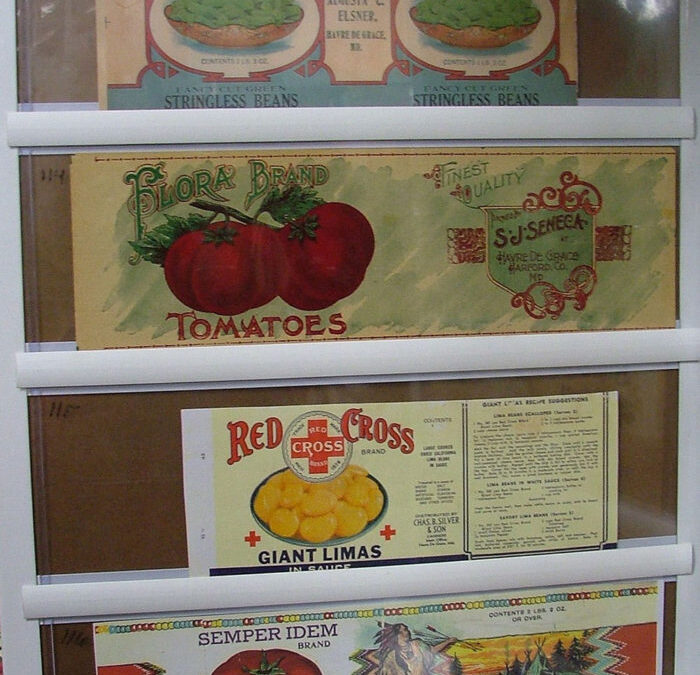Entering the 20th century, Havre de Grace’s canning industry was thriving.
CLICK HERE for a brief highlight of canning in Harford County.
EXAMPLE of labels that can be seen in our shop at Bahoukas.
Shortly after 1878, Stephen J. Seneca opened a fruit-packing factory in the S. J. Seneca Warehouse with a tin can factory next to Havre de Grace Waterfront. Seneca made improvements to canning with his patents; 1889 Can-soldering machine[12] 1891 Can-soldering machine[13] By 1899, Seneca had become a canned goods broker. Since the original railroad had run down St. Clair Street (now Pennington Ave.) to the river the location of the factory was advantageous for both water and rail shipping. Up until the Second World War many farmers in Harford County brought their produce to the Seneca Factory later run as Stockhams Cannery. S.J. Seneca lived at 200 North Union Ave. was Mayor of Havre de Grace 1893-1894 and donated the Methodist Church.[14]
The Seneca cannery, which is currently in use as an antique shop, is a very good example of a late 19th century brick industrial building. with its severally classical facade and massive stone buttresses on the rear.
from Wikipedia
Here’s another photo of area labels of the once, very profitable canning industry in Havre de Grace and surrounding areas.
Many patents followed the opening of the S. J. Seneca Cannery. 1901 The Baling-press.[15] 1905 The Cooker[16] 1905 The Tomato-scalder.[17] 1917 Improved Tomato-scalder.[18] 1917 The Can-opener.[19] 1918 The Machine for peeling tomatoes.[20]
from Wikipedia
Spencer-Silver Mansion, now a B&B, located at 200 S. Union Avenue, is an example of the wealth in Havre de Grace in the early 20th century.
The house was built to reflect the wealth and position of its original owner John Spenser, who was in the fish packing business. Along with the Seneca Mansion (HA 815) and the Van Diver Mansion (HA 1124), all on Union Ave., the house represents a small concentration of considerable wealth in the town at the turn of the century. The house was bought at auction in 1917 by Charles B. Silver, a local canning magnate. source: Maryland Historical Trust
You may also want to visit the Steppingstone Museum located within the Susquehanna State Park, at 461 Quaker Bottom Road, Havre de Grace. They have excellent exhibits of our rural history, including a great deal about our canning industry. Be sure to stop in to Bahoukas for more history of Havre de Grace and they’ll eagerly give you directions to other locations in Havre de Grace to learn more.





